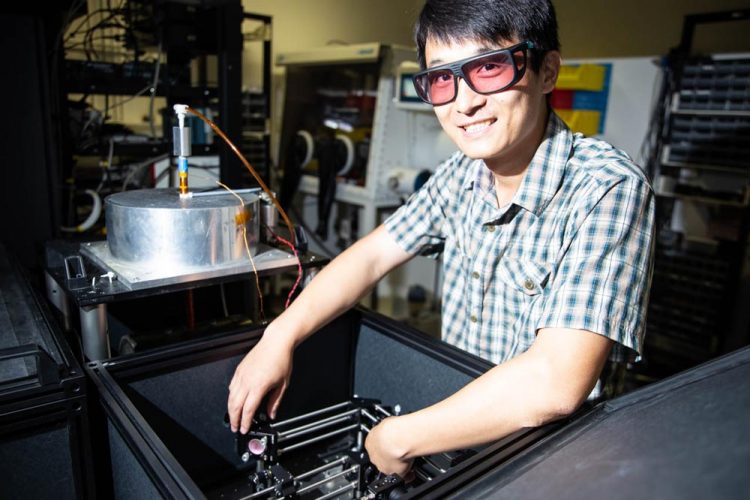Tracking down dark matter

Dr. Teng Wu aligning the probe laser beam of the comagnetometer setup photo/©: Arne Wickenbrock, JGU
Matter surrounds us day and night in all its forms – trees, houses, furniture, and even the air we breathe. But, according to physicists, the visible matter familiar to us may only account for approximately 20 percent of all material in the universe.
According to the current theory, as much as 80 percent may be dark matter. This claim is based on several observations, one of which is that stars and galaxies rotate much faster than they would if there were only 'normal' matter present in the universe.
Dark matter could be made of axions
Over time, scientists have developed different theories to explain exactly what this mysterious dark matter might be made of. Among the potential candidates that come into question are weakly interacting massive particles or WIMPs. Researchers have spent many years trying to hunt these down with particle detectors, as yet without success.
Several years ago, however, scientists proposed an alternative – a class of particles called axions, which are significantly lighter than other particles. According to the theory, the field of these particles oscillates, which means that it varies continuously.
The frequency of this oscillation is proportional to the mass of the particles, and, as this is extremely low, the frequency must also be low. But nobody knows just yet if that is the case. The problem is that the field oscillation is as likely to go through a complete cycle once a year as a trillion times a second.
Detecting axions with the help of nuclear spin change
Researchers at Johannes Gutenberg University Mainz (JGU) have now found a way of detecting axions with the help of the Cosmic Axion Spin Precession Experiment (CASPEr) program. “We are exploiting the potential of nuclear magnetic resonance,” explained Professor Dmitry Budker of the Institute of Physics at JGU and the Helmholtz Institute Mainz.
“This means we can identify the spin of nuclei within molecules, or, more specifically in our case, within the carbon isotope C13 and hydrogen.” The basic assumption is that dark matter can influence the spin of nuclei, hence providing researchers with a way of tracking it down. The spin, however, can also be influenced by the Earth's magnetic field.
The researchers use sophisticated shielding to suppress the magnetic field; however, even the best shielding in imperfect. The physicists must therefore decide which proportion of the observed spin changes are due to dark matter and which to the Earth's magnetic field. This led the team of scientists to develop its new comagnetometer configuration.
The principle underlying the technique is the fact that molecules generally contain different kinds of atomic nuclei. As the various nuclei will react to the magnetic field and dark matter to differing extents, it is possible to differentiate between these influences.
A part of the possible frequency range has now been investigated
The team at Mainz University have now combed through the range of frequencies from a few oscillations per year up to 18 oscillations per hour – as yet, without finding evidence of the effect of dark matter. “It's rather like looking for a lost ring in a vast garden,” said Budker.
“We have already searched part of the garden, so we now know this is where the ring – the axion – is not to be found. This has allowed us to considerably narrow down the range in which we hope to find the axion, and we can now focus our search on other ranges.”
Image:
http://www.uni-mainz.de/bilder_presse/08_physik_quantum_dunkle_materie_axionen.j…
Dr. Teng Wu aligning the probe laser beam of the comagnetometer setup
photo/©: Arne Wickenbrock, JGU
Related links:
* https://budker.uni-mainz.de/ – Budker Group at HIM and JGU
* https://www.hi-mainz.de/ – Helmholtz Institute Mainz (HIM)
Read more:
* http://www.uni-mainz.de/presse/aktuell/7645_ENG_HTML.php – press release “Physicists analyze the rotational dynamics of galaxies and the influence of the mass of the photon” (6 March 2019)
* http://www.uni-mainz.de/presse/aktuell/6769_ENG_HTML.php – press release “Earth's magnetic field measured using artificial stars at 90 kilometers altitude” (14 Nov. 2018)
* http://www.uni-mainz.de/presse/aktuell/6963_ENG_HTML.php – press release “Atomic parity violation research reaches new milestone” (13 Nov. 2018)
* http://www.uni-mainz.de/presse/20266_ENG_HTML.php – press release “ERC Advanced Grant for experimental physicist Dmitry Budker” (12 May 2016)
* http://www.magazin.uni-mainz.de/2452_ENG_HTML.php – JGU Magazine “Not everything in the universe is symmetrical” (9 Jan. 2015)
Professor Dr. Dmitry Budker
Helmholtz Institute Mainz (HIM) and
Quantum, Atomic, and Neutron Physics (QUANTUM) group
Institute of Physics
Johannes Gutenberg-Universität Mainz
55099 Mainz, GERMANY
phone +49 6131 39-29630
e-mail: budker@uni-mainz.de
https://www.blogs.uni-mainz.de/fb08-pmc/prof-dmitry-budker/
T. Wu et al., Search for Axionlike Dark Matter with a Liquid-State Nuclear Spin Comagnetometer, Physical Review Letters 122, 15 May 2019,
DOI:10.1103/PhysRevLett.122.191302
https://journals.aps.org/prl/abstract/10.1103/PhysRevLett.122.191302
Media Contact
More Information:
http://www.uni-mainz.de/All latest news from the category: Physics and Astronomy
This area deals with the fundamental laws and building blocks of nature and how they interact, the properties and the behavior of matter, and research into space and time and their structures.
innovations-report provides in-depth reports and articles on subjects such as astrophysics, laser technologies, nuclear, quantum, particle and solid-state physics, nanotechnologies, planetary research and findings (Mars, Venus) and developments related to the Hubble Telescope.
Newest articles

“Nanostitches” enable lighter and tougher composite materials
In research that may lead to next-generation airplanes and spacecraft, MIT engineers used carbon nanotubes to prevent cracking in multilayered composites. To save on fuel and reduce aircraft emissions, engineers…

Trash to treasure
Researchers turn metal waste into catalyst for hydrogen. Scientists have found a way to transform metal waste into a highly efficient catalyst to make hydrogen from water, a discovery that…

Real-time detection of infectious disease viruses
… by searching for molecular fingerprinting. A research team consisting of Professor Kyoung-Duck Park and Taeyoung Moon and Huitae Joo, PhD candidates, from the Department of Physics at Pohang University…





















